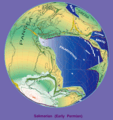Permian facts for kids
| Permian Period 298.9–251.902 million years ago |
|
| Mean atmospheric O2 content over period duration | c. 23 vol % (115 % of modern level) |
| Mean atmospheric CO2 content over period duration | c. 900 ppm (3 times pre-industrial level) |
| Mean surface temperature over period duration | c. 16 °C (2 °C above modern level) |
| Sea level (above present day) | Relatively constant at 60 m (200 ft) in early Permian; plummeting during the middle Permian to a constant −20 m (−66 ft) in the late Permian. |
|
Key events in the Permian
-300 —
–
-295 —
–
-290 —
–
-285 —
–
-280 —
–
-275 —
–
-270 —
–
-265 —
–
-260 —
–
-255 —
–
-250 —
An approximate timescale of key Permian events.
Axis scale: millions of years ago. |
|
The Permian was a very long period in Earth's history. It started about 299 million years ago (mya) and ended around 252 mya. This was the last period of the Paleozoic era. It finished with the biggest extinction event ever known on Earth.
Contents
Permian Climate
The climate during the Permian period changed a lot. At the very beginning, Earth was still in the grip of a big Ice age that started in the Carboniferous period. Huge glaciers covered parts of the land.
As the Permian continued, the climate slowly got warmer. The glaciers melted and pulled back. This warming made the insides of the big continents much drier. Towards the end of the Permian, the drying continued. Temperatures went through cycles of warm and cool periods.
Life in the Permian
During the Permian period, many different kinds of animals with four limbs (called tetrapods) became common. These included early amphibians, Sauropsids (like early reptiles), and Synapsids (like early mammals). They had all started to evolve in the Carboniferous period.
The first modern types of trees also appeared in the Permian. These included conifers (like pine trees), ginkgos, and cycads.
Permian Insects
The Permian was a time when insects really started to spread out and become very diverse. This is called an adaptive radiation. New types of insects appeared, like early Beetles (Coleoptera) and flies (Diptera).
Out of 36 known groups (or orders) of insects, 22 of them are known from the Permian. Some of these groups died out in the big extinction at the end of the Permian. But many more new insect groups appeared later in the Mesozoic era. By the end of the Permian, insects were probably the largest group of living things, based on the number of different species.
Early relatives of cockroaches were the most common insects. Big dragonflies ruled the skies. The first true Odonata (the group that includes modern dragonflies) also appeared in the Permian.
The Supercontinent Pangaea
During the Permian period, all the major land masses on Earth were joined together. They formed one giant super-continent called Pangaea. This huge continent stretched across much of the globe.
At the very end of the Permian, a massive event happened. Huge amounts of lava flowed out of the Earth's crust. These were the biggest flood basalt lava flows in Earth's history. They formed what are known as the Siberian traps. These lava flows caused world temperatures to rise a lot. They also severely damaged the environment.
Scientists are still discussing what exactly caused the huge extinction event at the end of the Permian. This event marked the end of the Permian and the start of the Triassic period. Many types of ocean life disappeared. For example, Trilobites, which had been very common in the ocean, became extinct. About 90% of all marine species died out during this time.
Images for kids
-
Selwyn Rock, South Australia, a rock showing marks from Permian glaciers
-
Hercosestria cribrosa, a reef-forming brachiopod (Middle Permian, Glass Mountains, Texas)
-
Edaphosaurus pogonias and Platyhystrix – Early Permian, North America and Europe
-
Dimetrodon grandis and Eryops – Early Permian, North America
See also
 In Spanish: Pérmico para niños
In Spanish: Pérmico para niños











